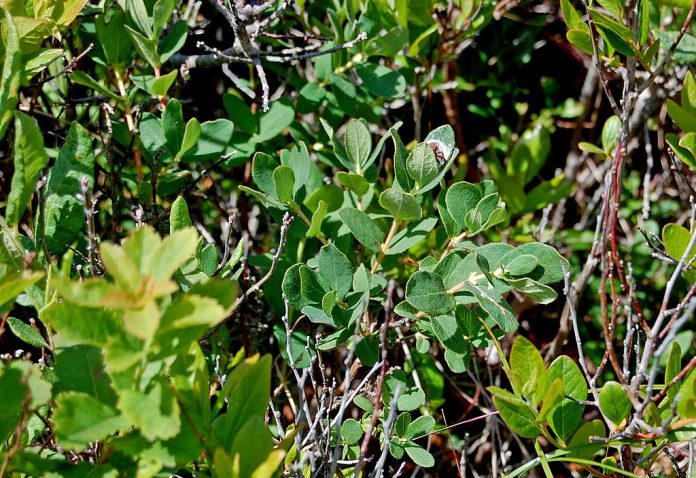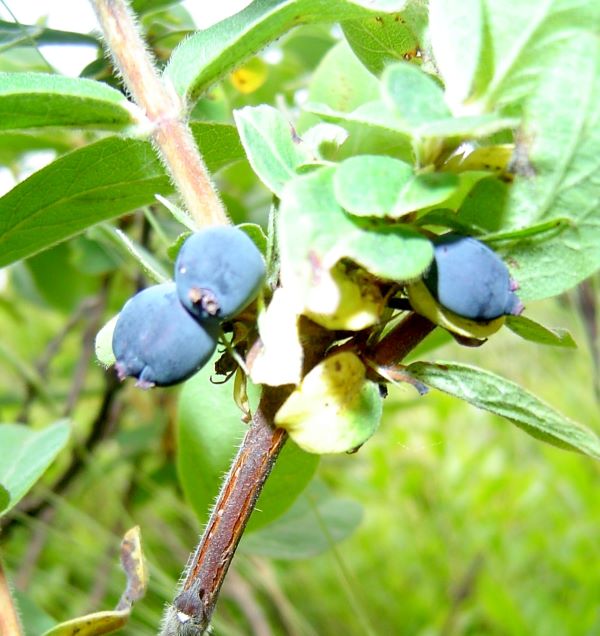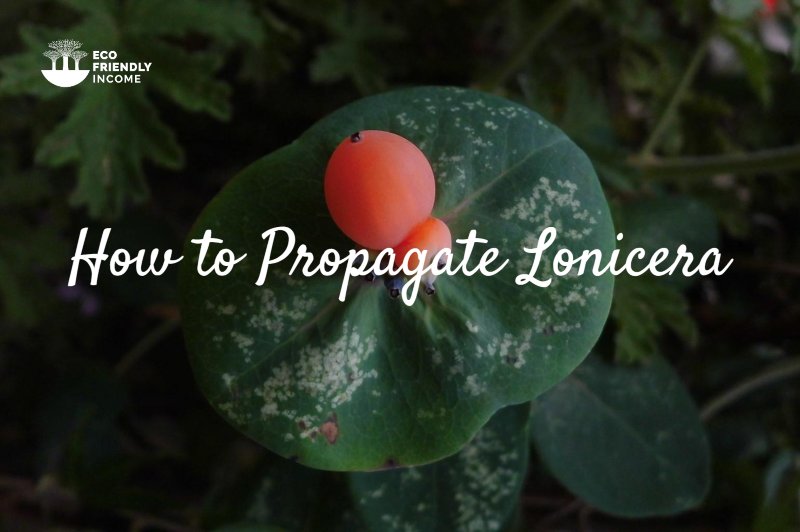
Featured Photo by jillllybean / CC BY-SA 2.0
A field guide on how to identify and propagate Mountain Fly Honeysuckle (Lonicera villosa), a hardy shrub that is native to eastern North America.
How to Identify Mountain Fly Honeysuckle (Lonicera villosa)
Leaves
Mountain Fly Honeysuckle leaves are ovate-shaped, with ciliate margins, and grow in opposite pairs on the stem.
They are covered with fine hairs that give them a velvety appearance. The leaves have smooth margins and are typically 1-4 inches long.
Fruit

Mountain Fly Honeysuckle are blue to black in color and are fairly large at 1/2 inch each. They’re in more of a oblong to oval shape and if you look closely, there’s a sort of waxy coating on them.
Mountain fly honeysuckle fruits are edible.
Flower
The flowers of Mountain Fly Honeysuckle are tubular-shaped and grow in pairs at the base of the leaves. They are typically a pale yellow color and have 5 triangular lobes that flare outwards.
Flowering Season
Mountain Fly Honeysuckle blooms in late spring or early summer, usually in June or July.
Habitat
Mountain Fly Honeysuckle can be found in a variety of habitats, including forest edges, open woods, and rocky slopes. It is most commonly found in the northern United States and Canada.
Some other understory plants that associate with mountain fly honeysuckle are:
- Creeping Snowberry (Gaultheria hispidula)
- Dewberry (Rubuspubescens)
- Paper Birch (Betula papyrifera)
- Black Spruce (Picea mariana)
- Jack Pine (Pinus banksiana)
Wildlife Value
Mountain Fly Honeysuckle is a valuable food source for a variety of birds and mammals, including:
Birds:
- Cedar Waxwings
- Hermit Thrushes
- Gray Catbirds
- American Robins
- White-tailed Deer
- Moose
How to Propagate Mountain Fly Honeysuckle (Lonicera villosa)

Hardiness Zone: 3-8

Soil Type: Well-drained clay, loam, sand.

Water: Normal to high.

Exposure: Full Sun to Partial Shade
You can propagate mountain fly honeysuckle with two effective methods:
- Stem Cuttings: It provides established shrubs faster, but is tricky and requires a mother plant.
- By Seed: If you can get your hands on seeds, you can sprout them at a large scale with a good chance of success.
How to Propagate Mountain Fly Honeysuckle (Lonicera villosa) by Seed
If you want to propagate mountain fly honeysuckle, starting from seed is a great option.
You can either collect wild seeds or purchase them online if available.
Once you have identified a wild fly honeysuckle shrub, you can proceed with harvesting the seeds by following these tips:
How to Harvest Seeds
Timing: Wait until the fruit is fully ripe, typically from mid to late summer through fall.

Extracting & Drying: Remove the pulp from the fruit and extract the seeds by mashing them on a screen. Dry the seeds and store them at room temperature until they are ready for stratification.
Stratification: For mountain fly honeysuckle, you need to put the seeds through a cold stratification process to break their dormancy. Put them into a ziplock bag with sand, moisten then place them into your refrigerator for 60 days.
Sowing
Scarification: Soak the seeds for 12-24 hours before you sow.
Starting Soil: Sift garden soil mix to remove large chunks and wood chips.
Sowing: Sow the seeds in early spring in a seed tray or individual pots at a depth of 1/16 inch. Cover lightly with soil and water regularly.
Germination: Mountain fly honeysuckle usually takes several weeks to germinate.
How to Propagate Mountain Fly Honeysuckle (Lonicera villosa) by Cuttings
If you want to propagate mountain fly honeysuckle, taking semi-hardwood cuttings is the best method.
These are the new growth from the current year that has hardened enough to be harvested without much risk of wilting.
Timing: Wait at least 6 weeks after the first spring leaves to harvest, and do it early in the morning while the plant is well hydrated.

Selection: Choose a young, healthy plant and cut a 6-8 inch section from semi-hardened stems. Older plants are less vigorous and less likely to root.
Preparation: Remove the lower leaves and dip the end in rooting hormone.
Soil Mix: Plant the cutting in well-draining soil, such as a mix of peat and perlite or coarse sand, ensuring the soil is moist but not waterlogged.
Rooting: Place the cuttings in a warm, bright location but not in direct sunlight. Mist them regularly to keep the leaves hydrated and the soil moist. After 4-6 weeks, the cuttings should root.
Transplanting: Once the cuttings have grown new leaves and rooted, they can be transplanted into larger pots or directly into the ground. Don’t forget to add slow-release fertilizing granules to promote healthy growth.
Mountain fly honeysuckle is a member of the lonicera family, and they all propagate in a similar way.
If you’d like a more in-depth guide on how to propagate lonicera, have a look at our parent article:

FAQ
A: Yes, unlike most honeysuckles, you can eat their fruits. Usually, they are used to make jams, jellies, and drinks.
